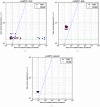Stability of bivariate GWAS biomarker detection
- PMID: 24787002
- PMCID: PMC4005767
- DOI: 10.1371/journal.pone.0093319
Stability of bivariate GWAS biomarker detection
Abstract
Given the difficulty and effort required to confirm candidate causal SNPs detected in genome-wide association studies (GWAS), there is no practical way to definitively filter false positives. Recent advances in algorithmics and statistics have enabled repeated exhaustive search for bivariate features in a practical amount of time using standard computational resources, allowing us to use cross-validation to evaluate the stability. We performed 10 trials of 2-fold cross-validation of exhaustive bivariate analysis on seven Wellcome-Trust Case-Control Consortium GWAS datasets, comparing the traditional [Formula: see text] test for association, the high-performance GBOOST method and the recently proposed GSS statistic (Available at http://bioinformatics.research.nicta.com.au/software/gwis/). We use Spearman's correlation to measure the similarity between the folds of cross validation. To compare incomplete lists of ranks we propose an extension to Spearman's correlation. The extension allows us to consider a natural threshold for feature selection where the correlation is zero. This is the first reported cross-validation study of exhaustive bivariate GWAS feature selection. We found that stability between ranked lists from different cross-validation folds was higher for GSS in the majority of diseases. A thorough analysis of the correlation between SNP-frequency and univariate [Formula: see text] score demonstrated that the [Formula: see text] test for association is highly confounded by main effects: SNPs with high univariate significance replicably dominate the ranked results. We show that removal of the univariately significant SNPs improves [Formula: see text] replicability but risks filtering pairs involving SNPs with univariate effects. We empirically confirm that the stability of GSS and GBOOST were not affected by removal of univariately significant SNPs. These results suggest that the GSS and GBOOST tests are successfully targeting bivariate association with phenotype and that GSS is able to reliably detect a larger set of SNP-pairs than GBOOST in the majority of the data we analysed. However, the [Formula: see text] test for association was confounded by main effects.
Conflict of interest statement
Figures












Similar articles
-
Performance of epistasis detection methods in semi-simulated GWAS.BMC Bioinformatics. 2018 Jun 18;19(1):231. doi: 10.1186/s12859-018-2229-8. BMC Bioinformatics. 2018. PMID: 29914375 Free PMC article.
-
GWIS--model-free, fast and exhaustive search for epistatic interactions in case-control GWAS.BMC Genomics. 2013;14 Suppl 3(Suppl 3):S10. doi: 10.1186/1471-2164-14-S3-S10. Epub 2013 May 28. BMC Genomics. 2013. PMID: 23819779 Free PMC article.
-
Genome-wide associations and detection of potential candidate genes for direct genetic and maternal genetic effects influencing dairy cattle body weight at different ages.Genet Sel Evol. 2019 Feb 6;51(1):4. doi: 10.1186/s12711-018-0444-4. Genet Sel Evol. 2019. PMID: 30727969 Free PMC article.
-
GBOOST: a GPU-based tool for detecting gene-gene interactions in genome-wide case control studies.Bioinformatics. 2011 May 1;27(9):1309-10. doi: 10.1093/bioinformatics/btr114. Epub 2011 Mar 3. Bioinformatics. 2011. PMID: 21372087 Free PMC article.
-
Finding type 2 diabetes causal single nucleotide polymorphism combinations and functional modules from genome-wide association data.BMC Med Inform Decis Mak. 2013;13 Suppl 1(Suppl 1):S3. doi: 10.1186/1472-6947-13-S1-S3. Epub 2013 Apr 5. BMC Med Inform Decis Mak. 2013. PMID: 23566118 Free PMC article.
Cited by
-
Spatial correlations exploitation based on nonlocal voxel-wise GWAS for biomarker detection of AD.Neuroimage Clin. 2019;21:101642. doi: 10.1016/j.nicl.2018.101642. Epub 2018 Dec 12. Neuroimage Clin. 2019. PMID: 30584014 Free PMC article.
-
Functional Mapping of Phenotypic Plasticity of Staphylococcus aureus Under Vancomycin Pressure.Front Microbiol. 2021 Sep 9;12:696730. doi: 10.3389/fmicb.2021.696730. eCollection 2021. Front Microbiol. 2021. PMID: 34566908 Free PMC article.
-
Collateral Sensitivity to β-Lactam Drugs in Drug-Resistant Tuberculosis Is Driven by the Transcriptional Wiring of BlaI Operon Genes.mSphere. 2021 Jun 30;6(3):e0024521. doi: 10.1128/mSphere.00245-21. Epub 2021 May 28. mSphere. 2021. PMID: 34047652 Free PMC article.
-
Phenotypic Plasticity of Staphylococcus aureus in Liquid Medium Containing Vancomycin.Front Microbiol. 2019 Apr 16;10:809. doi: 10.3389/fmicb.2019.00809. eCollection 2019. Front Microbiol. 2019. PMID: 31057516 Free PMC article.
-
Performance of epistasis detection methods in semi-simulated GWAS.BMC Bioinformatics. 2018 Jun 18;19(1):231. doi: 10.1186/s12859-018-2229-8. BMC Bioinformatics. 2018. PMID: 29914375 Free PMC article.
References
Publication types
MeSH terms
Substances
Grants and funding
LinkOut - more resources
Full Text Sources
Other Literature Sources
Miscellaneous

